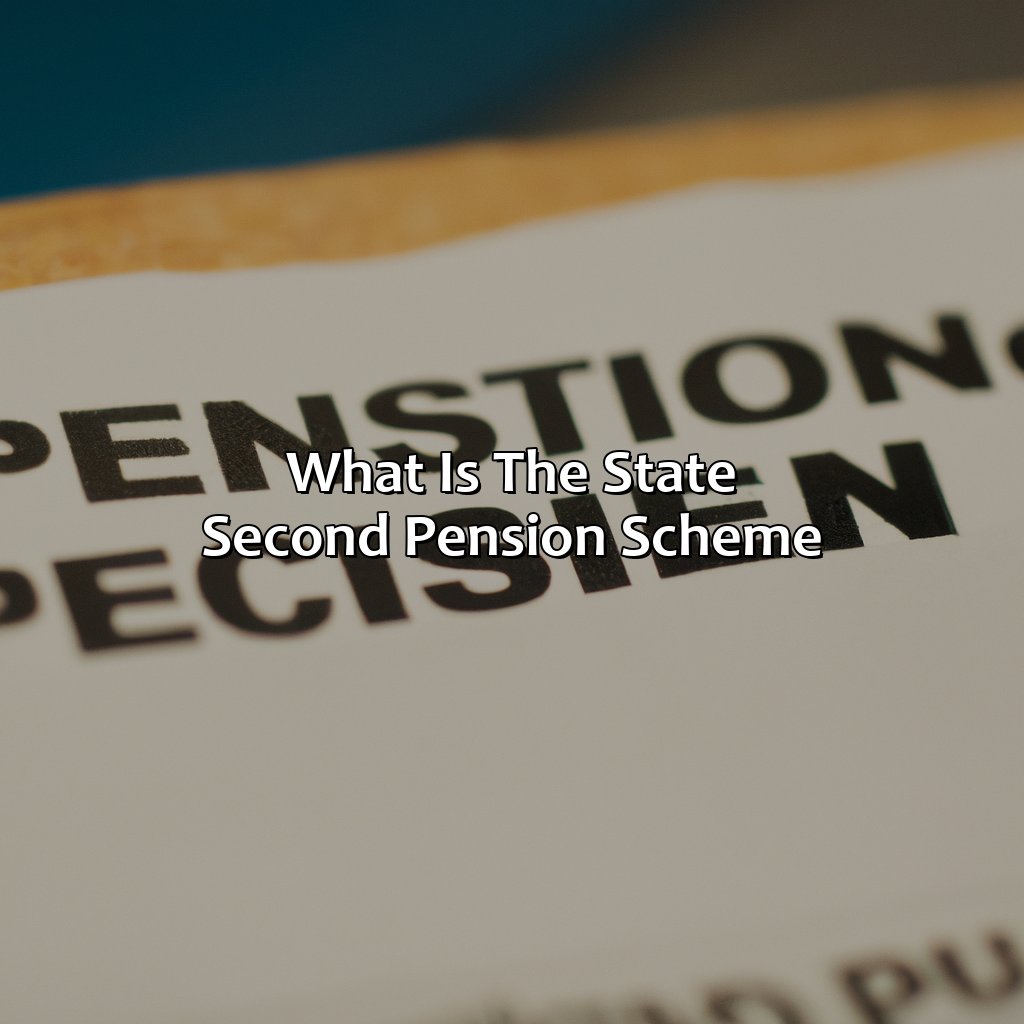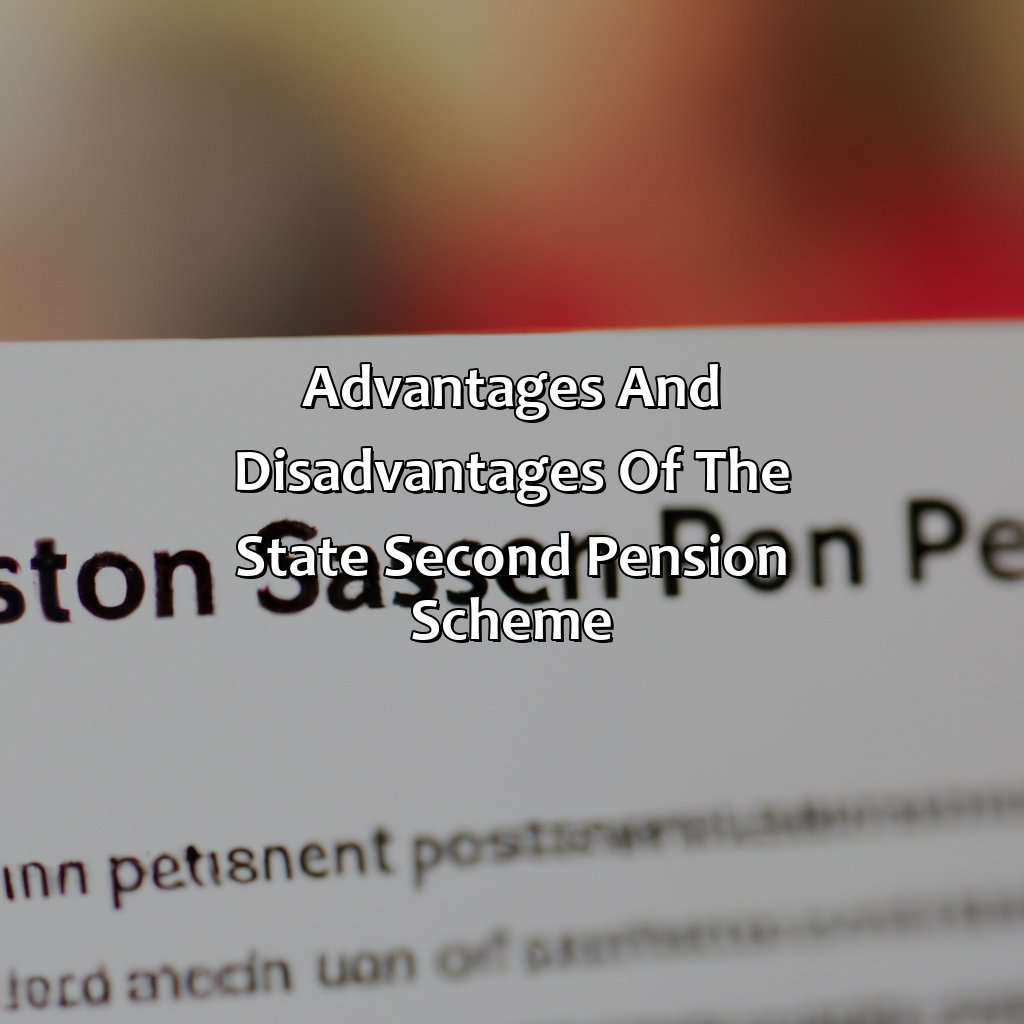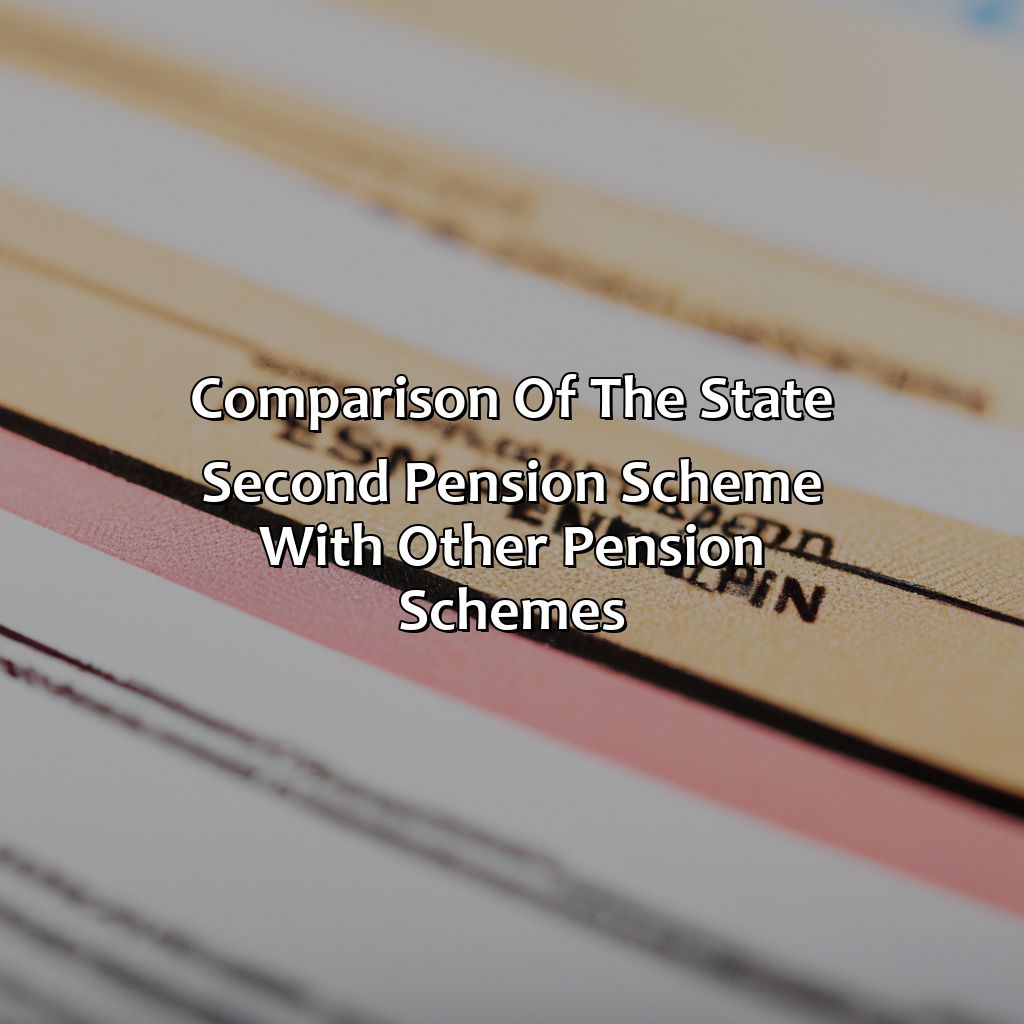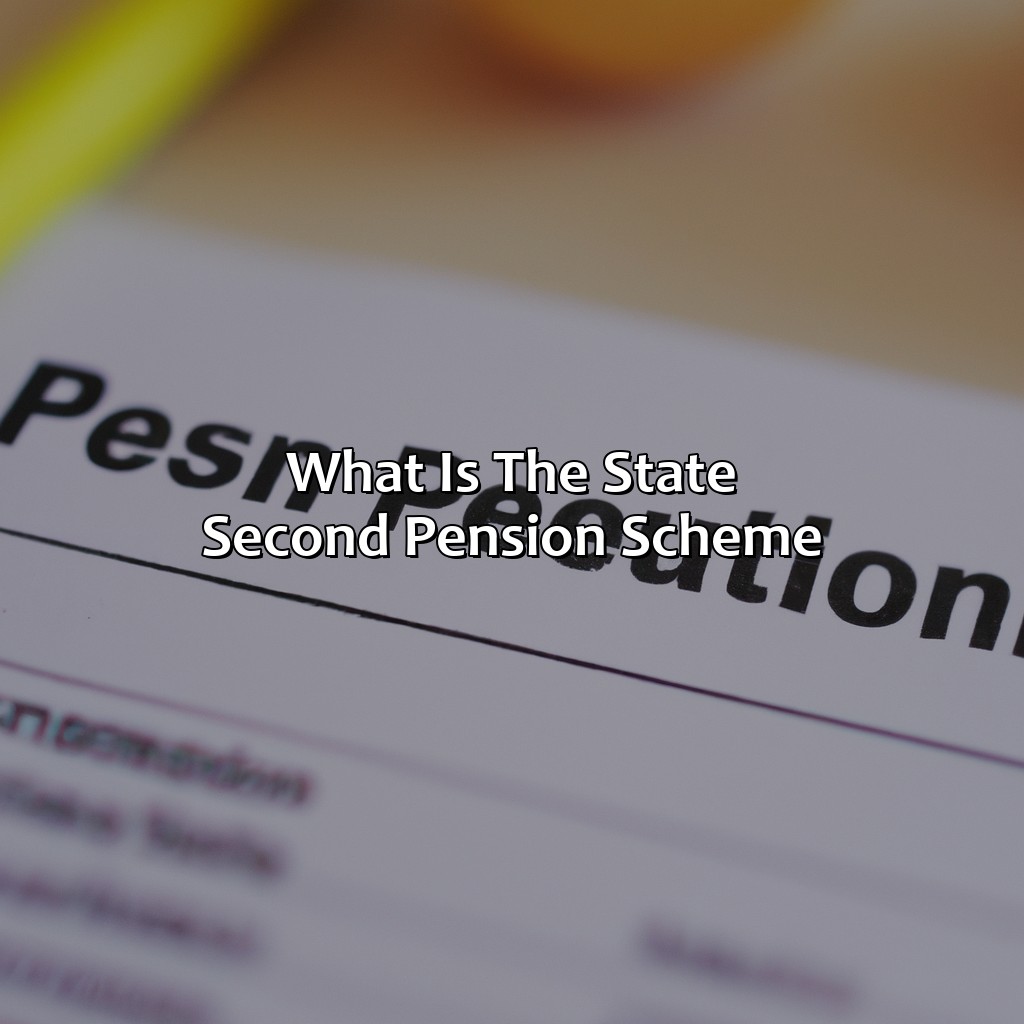What Is The State Second Pension Scheme?
Key Takeaway:
- The State Second Pension Scheme is a government-run pension plan in the UK that provides additional retirement income to eligible individuals. It is designed to supplement the Basic State Pension and can provide up to 175.20 per week in retirement benefits.
- To be eligible for the State Second Pension, individuals must have paid National Insurance contributions for a certain number of years and meet other requirements. The amount of benefits received is based on a complex calculation that takes into account an individual’s earnings history and other factors.
- The advantages of the State Second Pension Scheme include the additional income it provides in retirement, as well as the fact that it is backed by the government and therefore considered relatively secure. However, some disadvantages include the complicated eligibility and benefit calculation rules, as well as the fact that individuals may choose to opt out of the scheme in favor of other pension plans.
Struggling to understand your retirement options? You’re not alone. This article explains the State Second Pension – a valuable source of retirement income that could boost your retirement plans. Get informed, and give yourself the best chance of financial security in later life.
What is the State Second Pension Scheme?
Gaining insight into the State Second Pension Scheme? You must survey the plan’s summary and prerequisites for qualification. Doing so will confirm your right to benefits, and how they’re calculated and given, securing your retirement with financial stability.

Image credits: retiregenz.com by Joel Arnold
Overview of the State Second Pension Scheme
The State Second Pension Scheme provides an additional workplace pension for UK citizens earning above a certain threshold. This supplementary pension scheme is a top-up to the basic state pension, aiming to enhance pension benefits for those who qualify. It calculates pensions based on earnings and National Insurance contributions made from 1978 onwards. Thus, it aids in generating higher retirement income in addition to the basic state pension.
The State Second Pension Scheme began in April 2002, replacing the State Earnings-Related Pension Scheme (SERPS) and providing employees with more extensive benefits than SERPS previously offered. Individuals having a contracted-out private or occupational pension are not eligible, nor are individuals who reach the state pension age before April 6, 2002. However, people born after this date but before April 6, 1959, have different levels of entitlement based on various mechanisms
It’s crucial to be aware of one’s entitlement under the State Second Pension Scheme as it would significantly impact one’s post-retirement income. Not seeking information about one’s rights could result in missed opportunities to increase future financial stability during retirement. Plan ahead and acquire knowledge about what is a single life annuity pension from relevant government authorities or advisors. Remember – FOMO (fear of missing out) is real!
Looks like being mediocre pays off, as long as you meet the eligibility criteria for the State Second Pension Scheme.
Qualifications for Eligibility to the State Second Pension Scheme
Individuals can enroll in the State Second Pension Scheme if they meet specific criteria. This includes those who have been employed and were earning more than the National Insurance lower earnings threshold throughout their working life. On top of this, people who have been on maternity or paternity leave, long-term sick leave, or caring for someone may also be eligible. Those who have already contracted out will not qualify.
To be considered for the superannuation pension scheme, individuals must be between 16 and pensionable age and currently paying Class 1 National Insurance contributions. This means that self-employed individuals and those making voluntary contributions are not eligible.
It’s worth noting that since April 2016, new pension rules mean that individuals are no longer able to add to their State Second Pension. However, those who were already enrolled can continue to receive payments.
Interestingly, concerns over fairness have surrounded the scheme for some time, with many suggesting that it benefits high earners disproportionately. To address this issue, the UK government has made plans to replace it with a single-tier state pension from April 2016 onwards – an initiative designed to ensure everyone gets a fair deal in retirement regardless of their previous earning levels or work history.
If you are considering retirement plans, you may want to learn more about money purchase pension plans and how they work.
Calculating your benefits through the State Second Pension Scheme is like trying to solve a Rubik’s Cube blindfolded – confusing and frustrating for most.
Calculation and Payment of Benefits through the State Second Pension Scheme
The State Second Pension Scheme offers additional benefits on top of the Basic State Pension. Benefits are calculated based on various factors such as earnings and National Insurance contributions. Payments are made alongside the Basic State Pension, usually every 4 weeks.
The following table explains the factors used and calculation method in the State Second Pension Scheme:
| Factors Used | Calculation Method |
|---|---|
| Earnings | Proportionally |
| National Insurance Contributions | Number of years worked |
| Other pension benefits received | Decreases benefits accordingly |
It’s important to note that the State Second Pension Scheme stopped accruing benefits in April 2016. Those who started receiving payments before this date will continue to receive them, but no new applicants can join.
Don’t miss out on the potential benefits of the Category A State Retirement Pension if you’re eligible. Check your eligibility and start considering your options for a more secure retirement income.
The State Second Pension Scheme: where you can either retire comfortably or develop trust issues towards the government’s promises.
Advantages and Disadvantages of the State Second Pension Scheme
Weigh the State Second Pension Scheme’s good points and bad points? Look in the “Advantages and Disadvantages of the State Second Pension Scheme” section! There, you can find:
- “Advantages of the State Second Pension Scheme” explained in detail.
- “Disadvantages of the State Second Pension Scheme” explained in detail.

Image credits: retiregenz.com by David Washington
Advantages of the State Second Pension Scheme
The State Second Pension Scheme offers various benefits to its participants. Here are the key advantages in detail:
- Increased income – Those who participate in the scheme can receive additional income on top of their basic state pension.
- Flexible contribution options – Participants can choose to pay less or opt-out based on individual needs.
- Survivor benefits – Upon the death of a participant, their surviving spouse or civil partner may be eligible for a portion of the pension.
- No impact on other benefits – The scheme does not affect eligibility for other government benefits like housing or disability allowances.
- Guaranteed payment – The scheme is backed by the government and therefore considered a secure investment.
Another unique benefit of the State Second Pension Scheme is that it considers an individual’s national insurance contributions when calculating their pension entitlements.
According to GOV.UK, more than four million people had enrolled in the UK state pension by April 2016.
Looks like the state second pension scheme forgot to read the fine print in their own policy.
Disadvantages of the State Second Pension Scheme
The State Second Pension Scheme has its share of drawbacks that ought to be considered. Here are the demerits of engaging in the plan:
- Employers are left with higher expenses since they match monthly contributions from employees.
- A decrease in an individual’s weekly salary as a result of playing their part in contributing to the scheme.
- Riskier for self-employed individuals who receive no contributions boosts and must make higher contributions.
- No guarantee that the state pension benefits will be increased through this program and aren’t subject to inflationary adjustments due to frozen pension rules.
- The scheme operates on a Pay-As-You-Go System that could become financially unsustainable due to demographic pressures from ageing demographics and low birthrates.
Moreover, there is no assurance that funds saved under the scheme will be monetarily enough during retirement. Though built as supplemental revenue, it doesn’t cater equally to all market sectors. The increase in flexibility concerning pension programs may also lower its appeal.
In April 2002, Gordon Brown launched the State Second Pension Scheme as a replacement for SERPS (State Earnings Related Pension Scheme), believing SERPS would require much more funding each year than was received in revenue, making it unsustainable past 2025. While successful in operation thus far, some observe risks in such systems’ actual viability depending on foreign funding rates rather than national behaviour; should these rates fall, payment liabilities can spiral at a dangerous pace.
Pensions are like cars, there’s a range of options available but they all eventually break down.
Comparison of the State Second Pension Scheme with Other Pension Schemes
Compare the State Second Pension Scheme to other pension schemes. Assess the pros and cons. Get an idea of its features by looking at “Comparison of the State Second Pension Scheme with Other Pension Schemes“. It has two sub-sections. These are “Comparison with the Basic State Pension Scheme” and “Comparison with the Workplace Pension Scheme“. See how the State Second Pension Scheme stands out.

Image credits: retiregenz.com by Yuval Woodhock
Comparison with the Basic State Pension Scheme
When contrasting the State Second Pension Scheme (S2P) with the basic state pension, certain unique components must be considered. These include eminences such as qualification, amount and payment structure.
In order to visualize the discrepancy between these two schemes, a comparison table has been included below:
| Component | Basic State Pension | State Second Pension Scheme (S2P) |
| Qualification | 10 qualifying years of National Insurance contributions | Earn more than 6,240 per annum in National Insurance contributions |
| Amount | A maximum of 134.25 per week (April 2021 – April 2022) |
$172.28 per week or 8,967 annually minimum (2021-22 tax year) |
| Payment Structure | A lump sum back-payment on a weekly basis after reaching retirement age. The individual has no control over how this is paid back. |
A sum earned every tax year to enhance the basic pension amount. You can decide on how you receive this, either added incrementally to your current payment or paid together in a lump sum. |
It should be mention that the S2P benefits can be influenced by variables such as age, gender, and earnings history.
Pro Tip: It is essential to understand the qualifications required for each scheme early on and develop a retirement plan that utilizes a combination of various pension funds to maximize earnings.
You might as well flip a coin to decide between the state second pension and workplace pension schemes, but at least with the latter, you’ll have something to retire on.
Comparison with the Workplace Pension Scheme
When considering pension schemes, it is important to compare and understand the unique benefits of each. The following table presents a comparison between the State Second Pension Scheme and the Workplace Pension Scheme:
| State Second Pension Scheme | Workplace Pension Scheme | |
|---|---|---|
| Contribution Rates | Based on earnings between 6,240 and 50,000 per year. Allows for opt-out. | Minimum total contribution rate of 8%. Minimum employer contribution of 3%. |
| Eligibility | Automatically enrolled if earning above 10,000 per year. | Age eligibility of at least 22 and earning above 10,000 per year. |
| Benefits | Provides additional state pension based on earnings. | Provides employers with a workplace pension fund. |
Regarding contributions rates, the State Second Pension scheme bases its rates on earnings between 6,240 and 50,000 annually; an individual can choose to opt-out of this scheme as well. Comparatively, the Workplace Pension scheme has a minimum total contribution rate of 8%, with a minimum employer contribution of 3%. Eligibility requirements differ slightly- automatic enrollment occurs in the State Second Pension scheme if an individual’s annual earning exceeds 10k whilst age eligibility requires being at least 22 years old with an earning exceeding 10k annually in case of the Workplace Pension scheme.
In addition to these details, one should be aware that under both schemes they need to keep track of their own savings since retirement income calculations are personalized. According to gov.uk, “Around half get it automatically but others might need to
Image credits: retiregenz.com by James Washington
Who is eligible for the State Second Pension?
Individuals who have paid National Insurance contributions, including those with low earnings and self-employed individuals, are eligible for the State Second Pension. This additional pension is meant to supplement a person’s basic state pension and is dependent on their earnings record. The scheme is available to those who reached state pension age before April 6, 2016.
To qualify for the State Second Pension, one must either be an employee paying National Insurance contributions or self-employed and making Class 2 contributions. It is worth noting that not all employees are eligible for this pension as some may be part of a contracted-out workplace pension scheme.
It is essential to note that certain people may be entitled to more than others under this scheme. For example, those who have consistently contributed National Insurance payments at a high rate will receive higher payouts than those with a lower earnings record.
Many people have benefited from the State Second Pension Scheme over the years. One such individual was a low-earning single parent who had consistently paid into the system since the age of 16. Due to her consistent payment history and eligibility for this added benefit, she was able to retire comfortably with enough financial support from both her basic state pension and her State Second Pension payout.
If you’re wondering what does opt out of state pension mean, it means that you choose not to contribute to the state pension scheme and instead make your own arrangements for retirement.
It’s like opting out of your ex’s unexpected visit, but with money involved – yes, individuals can contract out of the State Second Pension.
Can individuals contract out of the State Second Pension?
Individuals may opt out of the State Second Pension scheme to channel their contributions elsewhere. This process is known as “contracting out.” Instead, employees and employers may choose to pay into a private pension scheme.
Why do I feel like I need a degree in advanced calculus just to understand how my State Second Pension is calculated?
How is the State Second Pension calculated and paid?
The State Second Pension Scheme payment is calculated based on your national insurance contributions and earnings. The more national insurance you pay, the higher your State Second Pension payment will be. The scheme is paid along with your basic state pension and can be received by individuals who meet the eligibility criteria.
To qualify for the State Second Pension, one must have been employed or self-employed in the UK and made sufficient national insurance contributions. Payments are made directly to eligible individuals’ bank accounts on a monthly basis.
Wondering what else you need to know about pensions in the UK? Check out our guide on pension sharing orders.
It’s important to note that the State Second Pension was replaced by a new system in 2016, called the New State Pension. This new system does not provide for an additional state second pension payment.
Interestingly, The Holy Grail of pensions – offering retirement benefits to live on once we stop working – originated as a medieval myth about King Arthur’s knights seeking a life-giving goblet.
What happens to the State Second Pension if an individual moves abroad?
When an individual moves abroad, their eligibility to receive State Second Pension benefits may change. The rules differ depending on the country of relocation and the type of pension plan offered in that country. It is advisable for individuals to inform the UK government’s International Pension Centre of their relocation plans at least three months in advance.
In some cases, an individual may be able to continue receiving their State Second Pension while living abroad, but they must meet certain criteria. For example, they must have made enough National Insurance contributions before leaving the UK and reside in a country that has a reciprocal agreement with the UK.
If an individual cannot continue receiving their State Second Pension, they may be able to transfer it into another pension scheme in their new country of residence. However, this option may not be available for everyone, and it is essential to seek professional advice before making any decisions. Learn more about what is a deferred pension and how it works.
Pro Tip: If you are planning to move abroad, make sure to research the pension rules and regulations of your destination country before making any decisions about your State Second Pension benefits.
Five Facts About the State Second Pension Scheme:
The State Second Pension Scheme is a UK government pension scheme that was introduced in April 2002. (Source: Pension Wise)
The scheme is designed to provide an additional pension benefit on top of the basic state pension. (Source: Money Advice Service)
The amount of additional pension received under the scheme depends on the individual s National Insurance contributions and earnings history. (Source: GOV.UK)
The State Second Pension Scheme was replaced by the new State Pension in April 2016. (Source: Pension Wise)
Individuals who reached state pension age before April 2016 may still receive additional pension under the State Second Pension Scheme. (Source: Money Advice Service)
FAQs about What Is The State Second Pension Scheme?
What is the State Second Pension Scheme?
The State Second Pension Scheme (S2P) was a UK Government scheme that provided an additional pension on top of the basic state pension. It existed from 2002 to 2016 and was designed to top up the pensions of people who were eligible for the basic state pension.
Who was eligible for S2P?
Most people who made National Insurance contributions and were of working age were eligible for S2P. This included those who were self-employed and those who were employed. However, there were some exceptions, such as certain types of workers who did not pay National Insurance contributions.
What did S2P provide?
S2P provided an additional pension on top of the basic state pension. The amount of the additional pension was based on the person’s National Insurance contributions and their earnings. The more a person earned and the longer they had been making National Insurance contributions, the higher their S2P entitlement would be.
Why was S2P abolished?
S2P was abolished as part of wider pension reforms introduced by the UK Government in 2016. It was replaced by the new State Pension, which is designed to be simpler and easier to understand. The new State Pension is a flat-rate pension based on a person’s National Insurance contributions.
Will I still receive S2P if I’m already retired?
If you reached state pension age before 6 April 2016, you will still receive any S2P entitlement that you built up before that date. However, if you reached state pension age on or after 6 April 2016, you will not receive S2P, but will instead receive the new State Pension.
Can I transfer my S2P entitlement to a private pension?
No, it is not possible to transfer S2P entitlement to a private pension. However, you may be able to transfer any additional pension entitlements you have built up through an occupational pension scheme.
 Checkout this IRS Loophole
Checkout this IRS Loophole 
